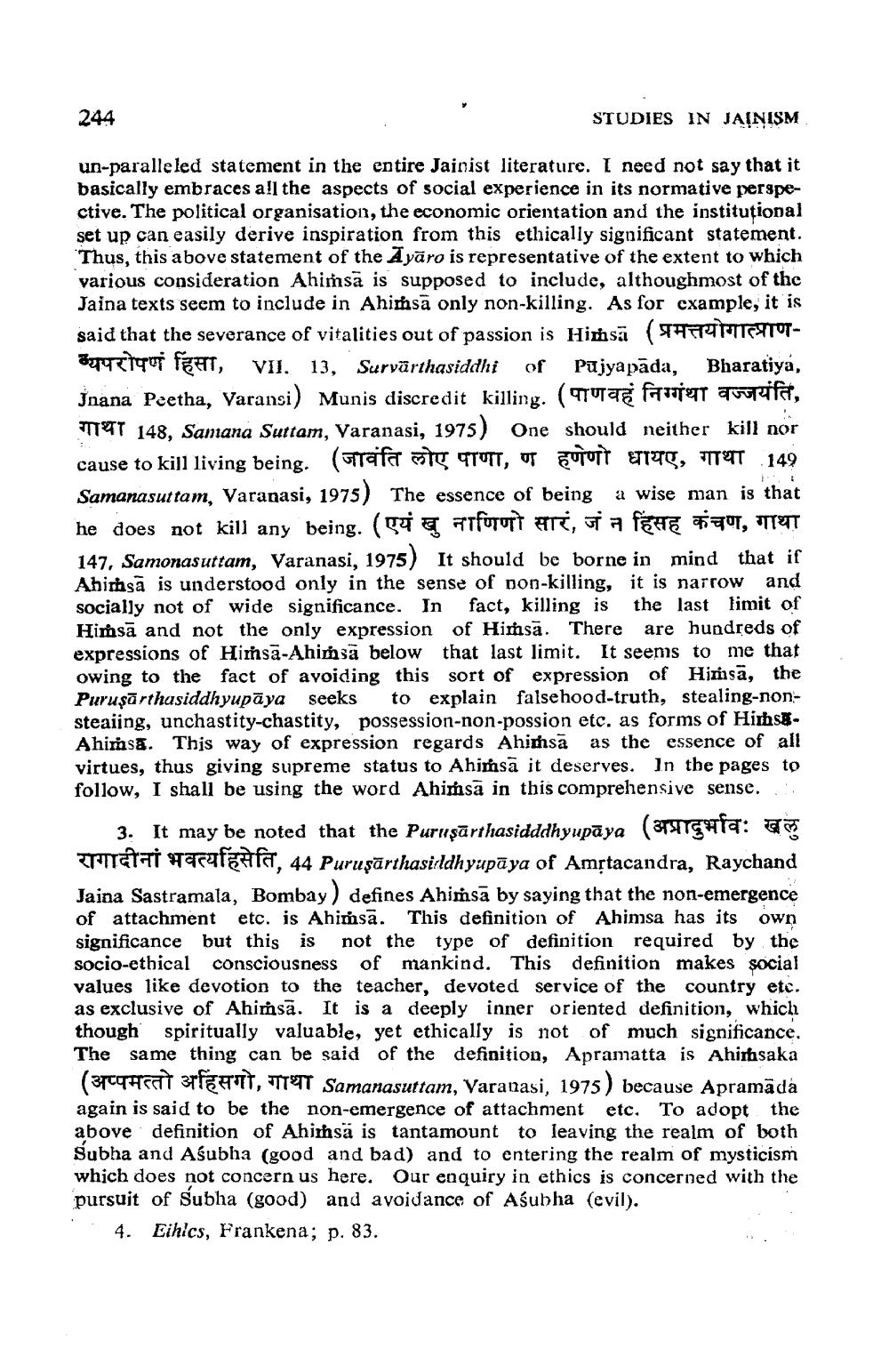________________
244
STUDIES IN JAINISM
un-parallelebraces all the asion, the econ
un-paralleled statement in the entire Jainist literature. I need not say that it basically embraces all the aspects of social experience in its normative perspective. The political organisation, the economic orientation and the institutional set up can easily derive inspiration from this ethically significant statement. Thus, this above statement of the Ayāro is representative of the extent to which various consideration Ahimsa is supposed to include, althoughmost of the Jaina texts seem to include in Ahimsā only non-killing. As for example, it is said that the severance of vitalities out of passion is Himsa (प्रमत्तयोगात्प्राणSTT TITUT FEHT, VII. 13, Survärthasiddhi of Pujyapāda, Bharatiya, Inana Peetha, Varansi) Munis discredit killing. (TUTTE froigt avrifat,
TOT 148, Samana Suttam, Varanasi, 1975) One should neither kill nor cause to kill living being. (Taifa Star OTOTT, UT FUTOTT E71275, TTT 149 Samanasuttam, Varanasi, 1975) The essence of being a wise man is that he does not kill any being. (Tug afforori ari, JT a EHE FUT, TT 147, Samonasuttam, Varanasi, 1975) It should be borne in mind that if Ahirhsā is understood only in the sense of non-killing, it is narrow and socially not of wide significance. In fact, killing is the last limit of Himsā and not the only expression of Himsā. There are hundreds of expressions of Himsa-Ahimsā below that last limit. It seems to me that owing to the fact of avoiding this sort of expression of Himisā, the Puruşārthasiddhyupāya seeks to explain falsehood-truth, stealing-nonsteaiing, unchastity-chastity, possession-non-possion etc. as forms of HirhssAhimsa. This way of expression regards Ahimsa as the essence of all virtues, thus giving supreme status to Ahimsā it deserves. In the pages to follow, I shall be using the word Ahimsa in this comprehensive sense.
3. It may be noted that the Puruşārthasidddhyupāya (TSITGHT: Trái saratania, 44 Puruşārthasildhyupāya of Amstacandra, Raychand Jaina Sastramala, Bombay) defines Ahimsa by saying that the non-emergence of attachment etc. is Ahinsa. This definition of Ahimsa has its own significance but this is not the type of definition required by the socio-ethical consciousness of mankind. This definition makes social values like devotion to the teacher, devoted service of the country etc. as exclusive of Ahirnsa. It is a deeply inner oriented definition, which though spiritually valuable, yet ethically is not of much significance. The same thing can be said of the definition, Apramatta is Ahimsaka (3109HT SCATT, TTTT Samanasuttam, Varanasi, 1975) because Apramada again is said to be the non-emergence of attachment etc. To adopt the above definition of Ahirhsa is tantamount to leaving the realm of both Subha and Aśubha (good and bad) and to entering the realm of mysticism which does not concern us here. Our enquiry in ethics is concerned with the pursuit of Subha (good) and avoidance of Aśubha (evil).
4. Eihics, Frankena; p. 83.




